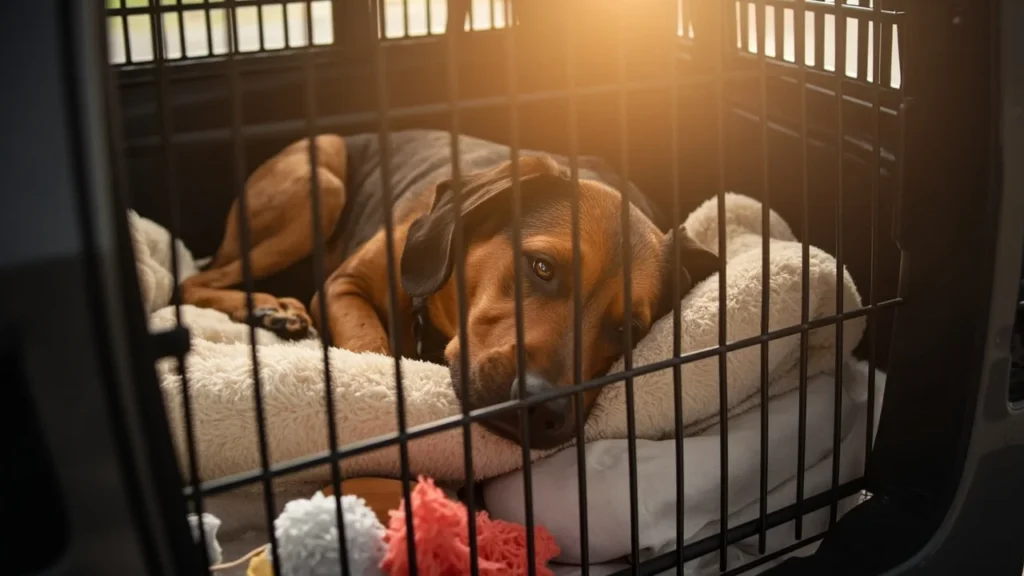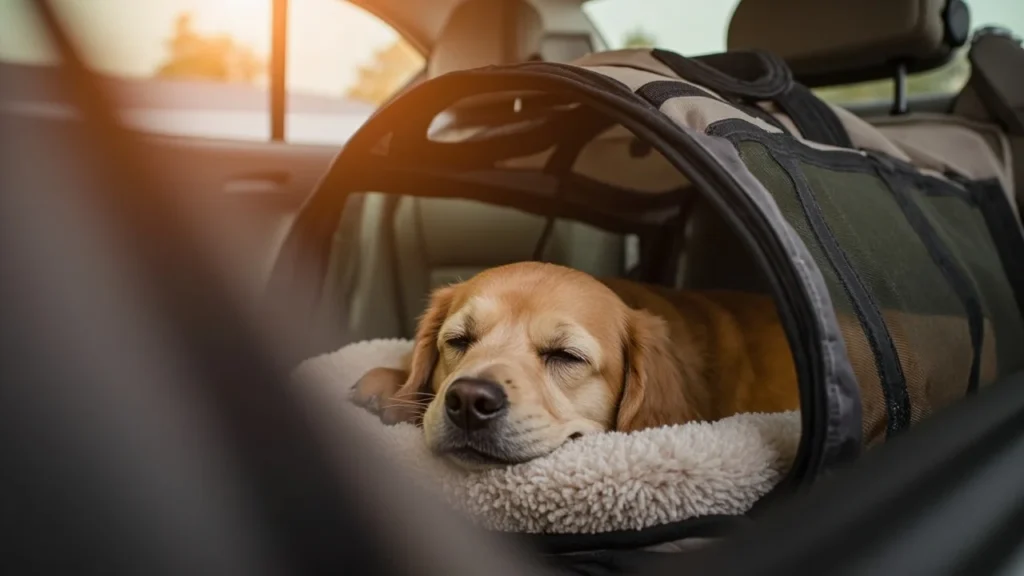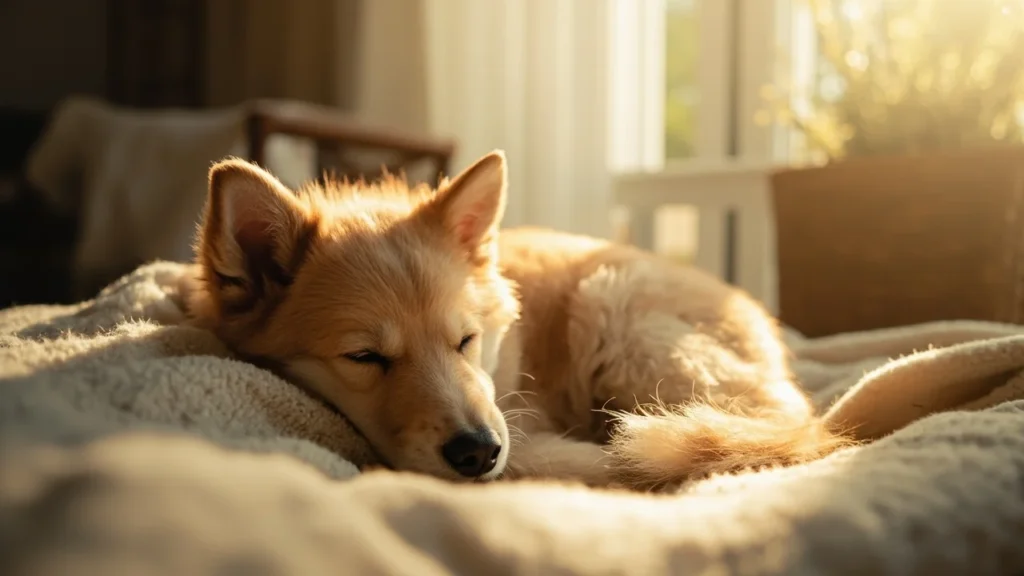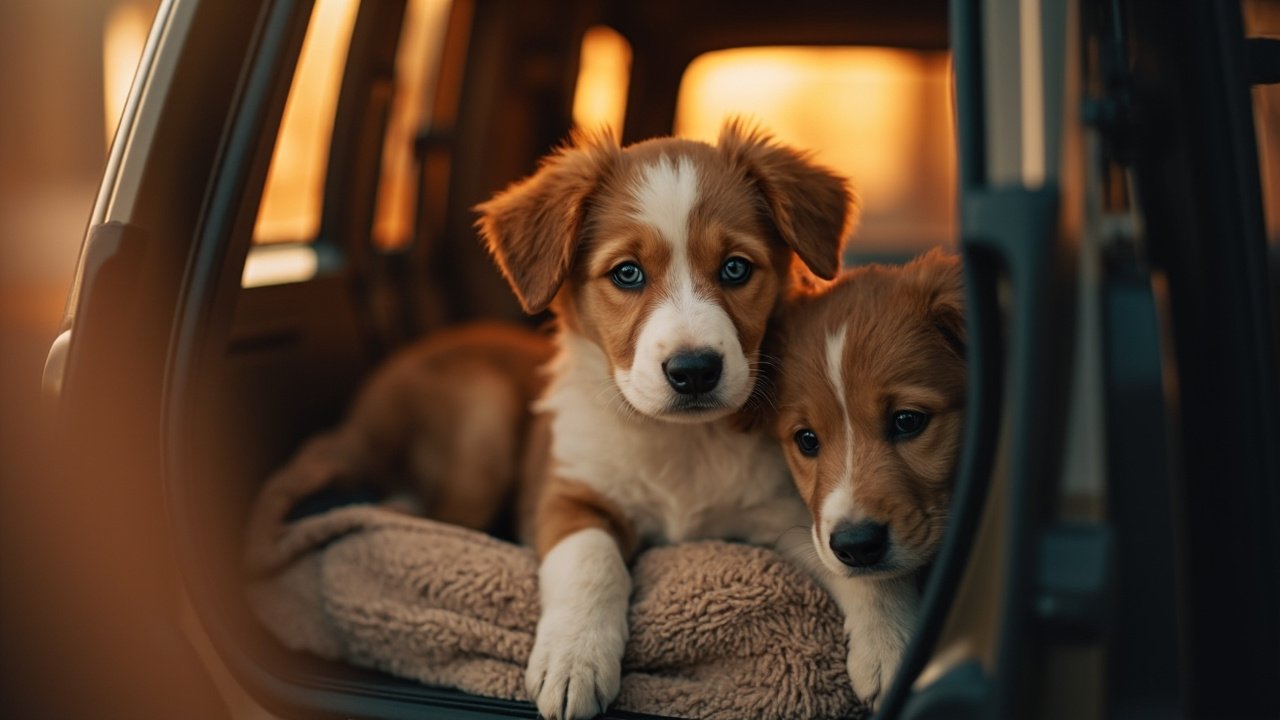Traveling with a pet, it is a unique experience, and at the same time, challenging. For lots of people, their pets are like members of the family, and because of this, the idea is to leave them behind during a trip can be stressful. Yet, traveling with them is much more to it than just putting them in a car or an airplane. The stress of travelling with pets-it can be a major barrier to make sure that both you and your pet to enjoy the ride smooth and comfortable. In this article we are going to share with you tips and techniques that really work to reduce your stress during the travel, ensuring you a safe and pleasant for both of them.
Summary of the Content on
The Stress of travelling with Pets-What You Need to Know
Before I talk about the techniques to reduce the stress of travel with your pets, it is essential to understand what actually causes this stress. Animals, like humans, are made to feel insecure and anxious in new situations, and it is the journey of a radical change of environment for them. In order to understand it better, we're going to explore what's really happening with your pet during your trip.
How Stress Affects your Pets During Travel
The the stress you are travelling with pets - it can manifest itself in a variety of ways. When the animal is exposed to new environments and situations beyond your control, fear and anxiety can be triggered, which will, in turn, can have an impact on the behavior and health of your pet. In addition, the stress-it can have physical effects on the body of the animal, such as an increase in heart rate, digestive problems, and even a weakening of the immune system.
For dogs, the main symptoms of stress, while in the field, which include shortness of breath, excessive salivation, tremors, vocals documents (such as barking), and, in more severe cases, vomiting, or diarrhea. Since the cats, because they are more sensitive to changes, they can go into hiding, to stop, to eat, or to display aggressive behavior when they feel threatened or out of your comfort zone.
The stress is prolonged, it may affect the behavior of the animal in a more long-lasting, making him feel more nervous than before, or even really aggressive in a similar situation in the future. Therefore, it is very important to take action to alleviate that stress as much as before.
How to Reduce the Stress of travelling with Pets-Techniques-and-Tips
Now that we understand how stress affects our furry friends, we're going to explore the main techniques that can help reduce the discomfort during the trip. Every pet is unique, and the approach may vary, depending on the behavior and the needs of the individual, but with the following tips that are proven to help with many of the owners of the pets to create a road trip more smooth.
1. Advance preparation: Before the trip
Preparing in advance is the first step to avoid the stress of travelling with your pets, and to ensure that your ride will be smooth for your pet. Many times, stress is simply because the animal is not ready for the experience. Here are a few tips to make sure your pet is as comfortable as possible prior to the start of the journey.

Accustom your Pet to the Carrier or crate
If you are going to travel by car, plane, or train, it is highly possible that you will need to use a crate for your pet. And, like any pet, the pets can feel the fear of, or resistance to new places, especially when they're put in is something that they don't know him that well. The solution to this is to begin the process of adaptation as soon as possible.
To begin with, in advance, by placing your pet in a crate in the house for a short period of time. Make sure that your pet associates the crate with positive moments, food, toys, and love. Never force your pet to get in the box, as this could create a negative association. In the course of time, gradually increase the time it goes on the inside of the box, it's always with a positive rewards.
In addition to this, you must ensure that the box will be the correct size. This should be big enough for your pet to stand, turn around and lie down comfortably, but not so large that you feel lost inside of it. This will help to create a sense of safety and security.
Queries To The Veterinary
Before traveling with your pet, it is essential to schedule an appointment with your veterinarian. You can check to see if your pet is healthy and fit to travel. It may also be able to advise you on what to do to alleviate the anxiety disorders, suggesting that the drugs or natural treatments, such as pheromones, synthetic, which helps to relax the animal.
In some cases, your veterinarian may recommend a medication anti-anxiety drugs or sedatives, as light, especially if your pet already has a history of stress while on the go. Always follow the directions of the veterinary surgeon, and never give medication on his own account.
Food and drinks
One of the main concerns when traveling with your pets is to make sure that they stay well-fed and hydrated. To avoid giving the big meal just before you journey, as this may cause nausea, and discomfort, especially if you are on a path to long. The ideal is to feed your pet a few hours before you travel, and give you smaller portions throughout the course.
Light, water, and snacks along the way, especially if it will be a long one. A few stopped to offer water to allow your pet to stretch their legs, they can do wonders for your well-being with him.
2. During a Journey: by Creating a Peaceful Environment

During the trip, the first priority is to keep your pet as comfortable as possible. Here are a few strategies to make sure that it is quiet, as long as you follow your path.
Keep your Pet in a Comfortable setting
If you are traveling by car, it is essential to ensure that your pet has a safe and comfortable way. Leave the pet in a crate in the back seat or use a seat belt for the dog, who remains incarcerated in a secure way. Avoid letting your pet is loose as it may hurt yourself in case the car needs to brake all of a sudden.
Read more: Beaches for Pets-get to Know the Best Destinations to have some Fun with your Four-Legged Friend
If you are traveling by plane, choose a crate that will be approved by the airline, and that it provides proper ventilation is provided. Also, check with the specific rules of the company for the carriage of animals as they move. On the plane, you put a blanket over the crate, you can help reduce audio and visual stimuli.
Avoid Loud Noises and Sudden Movements
Loud noises can be a big stressor for the event. Avoid loud music, conversations, intense, and any other noises that you could stir in the animal kingdom. In the car, and then try to drive smoothly, without sudden movements. Stops on a regular basis for your pet to stretch out, are also important, especially on long trips.
On the plane, so, if possible, choose a direct flight to minimize travel time and exposure to new stimuli. It's also worth checking the weather forecast and the status of the flight, to make sure that you don't encounter the unforeseen circumstances that may increase the stress on your pet.
Keep Calm
If you are nervous, your pet can see it and be looking forward to it. Pets are highly sensitive to the behavior of people, so it's important to stay calm and talk to your pet, so gentle and reassuring. Use kind words and be sure to let him or her know that you are safe and secure.
3. Care of the Post-Tour: Soothing for Your Pet, After the Arrival of
After a long trip, it is important that you ensure that your pet has enough time to recover and adjust to the new environment. Many of the times, the pets can feel like a huge burden of stress upon the way, and they need to take some time to relax and unwind.
Let us Explore the following resources:
When you arrive at the destination, you allow your pet to explore our new site to a few. To avoid forcing you to interact with a new environment, or to people right away. Take your time to smell up the place, to become familiar with the sounds and smells around him.
Provide a quiet space where your pet can rest. It may be a corner in particular from the house, a room is reserved, away from the intense movement of people, animals and the unknown.
Give it room to spread out
After the stress of travel, for your pet, you may be tired, and looking forward to the rest. Avoid any intense activity, immediately after their arrival, and let it relax for a few hours. This will help the animal to recover, both physically and mentally.
4. Relaxation techniques for presidents-Elect training seminar
If you are looking for an additional way to help your pet to wind down during your trip, there are a few relaxation techniques that could be helpful to you. They are natural, and is often effective in the management of anxiety.
Aromatherapy for Pets
Aromatherapy can also be a great tool for helping to reduce the anxiety of the event. Essential oils such as lavender, chamomile, and valerian to have soothing and calming properties, can be used to create a relaxed environment for your pet. There are a diffusion of the environment, especially to made-for-presidents-elect training seminar, where you can just add the essential oils.
Before using any essential oil, make sure that it is safe for your pet, as some essential oils can be toxic to dogs and cats. Always consult with your veterinarian about the use of aromatherapy as well.
Calming Music
Some studies have found that soft music with a frequency of 50 to 60 beats per minute, which can help you to reduce the stress in dogs and cats. There are playlist and Cd players, specifically created to relax for your pets. To play these songs during the ride, or while your pet is adjusting to a new environment can help you feel more secure and at ease.
5. Drugs & Supplements for Reducing Anxiety
In the most severe cases of stress, medications, and supplements may be an effective option. Always consult with your veterinarian before administering any type of medication. There are options for drug anti-anxiety drugs that are specific for the pets, we can help you ease anxiety during travel or long-term stress.
In addition to this, there are natural supplements, such as those containing CBD, which has shown positive results in the alleviation of anxiety in dogs. These add-ons could be used as an alternative for those who prefer a more natural ingredients.
6. The adaptation to Post-Trip Tips to Keep Your Pet Calm in the New Environment

After the wear and tear of a long journey, your pets will often feel tired and a little out of whack. Just as we are, they may need to take some time to get used to the new environment. Adaptation is an important part of ensuring that they feel safe and comfortable in the new space, which helps to reduce the stress of the journey.
To arrange for a Quiet Space for Your Pet
When you arrive at the destination, the first thing you need to do is find a peaceful place where your pet can rest. It is therefore essential to make sure that he feels safe and relaxed, away-from new stimuli and environments: active.
If you are in a hotel, house or apartment is the temporary, to create “a zone of comfort for your pet with a bed, toys, and other items for family members, as the dog's leash, or a blanket. This can help to reduce the anxiety of your pet by creating a place he recognizes, and make you feel secure.
Give them Time To Adjust
As well as you will need time to get used to a new environment, your pet will also need to. Avoid forcing your pet to socialize with people and other animals, as soon after their arrival. Give them the time to explore your new environment by slowly, ever so calm and in no hurry.
Please note, the behavior of it. If it seems to be under a heavy load, let it alone for a long time for him to rest and recover. To the extent that it suits you, you can begin to introduce new activities, and interact with the site.
To Avoid Excessive Stimuli
During the upgrade, please try to keep your interactions with your pet is calm, and no hype. In the hustle and bustle of new places, people and sounds that could be stimulating, too much and it hurt to adapt. Keep in mind that patience is the key. How much more of a smooth step-by-step for the process, the easier it will be for your pet to adjust to the new environment.
7. Caring for the Health of Your Pet During the Journey
For the health of your pet during a trip, it is also a crucial factor. In addition to the emotional stress of the trip, you can make an impact on the physical well-being of your pet. For this reason, it is important to have a plan in place to care in the proper order to ensure that your pet is healthy in the course of the entire trip.
Please check the Vaccination and Health check
Prior to any trip, especially if you are traveling to a different destination, or international level, it is important to make sure that their vaccinations and health checks for your pet to be. So, it is important not only for the health but also to avoid problems related to the regulation of the transport.
Some countries and / or states require that all pets have certain immunizations or a health check on a specific topic. For example, international travel, may require the submission of a health certificate signed by a veterinary surgeon, in addition to proof of immunization against diseases such as rabies. Please verify with the requirements of the destination in advance and plan your trip to allow sufficient time to meet the new requirements.
Care of the Food For the Journey
A proper diet while on the road is another major concern. During long trips, it can be hard to feed your pet on a regular basis but that doesn't mean that you should neglect his needs.
If you are traveling by car, plan your stops on a regular basis to provide water and food to your pet. It is important to keep the power of the animal, as well as to avoid discomfort such as nausea and constipation. If you're on a flight, keep in mind that the meals may be limited, then, to provide the food on your pet prior to departure.
In addition to that, make sure that your pet has constant access to water. This is especially important on long journeys, in which dehydration can be a problem. The opinions of the car, you can use soap and water, automatic, for pets, it can be very useful and practical when traveling.
Keep your Pet Active
Traveling for long periods of time can be stressful for anyone, even for the animals. So, make sure to keep your pet in place so he can feel better during the trip. In the case of the driving, always make sure to take sufficient breaks, so that the animal can get out of the box, for shipping, walk around, and stretch your legs.
If at all possible, take short walks for your pet to exercise and relieve built-up stress. These breaks will also help to break down the pace of the journey, making the ride more pleasant and comfortable for both you and your pet.
8. When To Seek Professional Help
In some cases, in spite of all the precautions and strategies, and the stress of the trip can be very intense for the pet. If you notice that your pet is suffering more than you expected, it may be time to seek professional help. Don't be afraid to look for in a veterinarian with behavioral, or an expert on the animals and to discuss solutions to the most specific.
Behavioral Therapies
If your pet has a history of severe anxiety in the travel or other stressful situations, behavioral therapy may be a useful option. A health professional may help you diagnose the reason behind the anxiety of your pets and work with you on a tailor-made strategies to help you deal with these situations.
Drugs or Natural Supplements
In extreme cases, a vet may recommend a medication anti-anxiety drugs or sedatives to help you manage stress on your pet during the trip. These drugs usually are temporary and shall be administered in accordance with the recommendation of the specialist.
There are also add-ons natural, herbal remedies to calm down, that might be useful, such as chamomile and valerian. These add-ons may be given to you prior to the trip and to help you relax for your pet without sedá it.
Traveling with Your Pet Can Be a Positive Experience
Travelling with the pet can seem like a daunting task, but with the strategies, and the care of some, the experience can be a pleasant and calm for the both of them. The key is to be well prepared, both emotionally and practice, as well as to ensure that your pet is comfortable at all times. If you follow the tips and techniques we have discussed, how to get used to his new pet with a carrying case, make sure that it has a very quiet place to rest, and to use the techniques of natural wellness center, you will be creating a conducive environment for a trip to a more peaceful and stress-free.
Let's not forget that, as soon as you do, your pet will also feel the changes and the stress of travel. That is why, with patience and care, it is possible to do the journey in a positive, allowing both of them to take full advantage of the experience.
Bullet Points: Top Tips to Reduce the Stress of travelling with Pets -
- Get your pet used to their new pet with the crate prior to travel, to create positive associations.
- Talk to your veterinarian to ensure your pet is healthy and fit to travel.
- Feed your pet a few hours before the journey, and bring snacks and water for the journey.
- Keep your pet in a safe place and comfortable fit, be it in the car, on a plane or train.
- Make regular stops during the trip you in order for your pet to stretch their legs and drink some water.
- Create a calm and welcoming environment for your pet after you arrive at your destination.
- Use relaxation techniques, such as aromatherapy and music is very soothing, in order to reduce the anxiety.
- Consider the use of medications, or natural supplements, always under the supervision of veterinary.
Faq
1. How can I tell if it's the stress of the trip is affecting you, my pet?
The common signs of stress in pets, which include trembling, shortness of breath, loss of appetite, calls for excessive (barking or meows), and the behavior of aggressive or lethargic. If you notice any of these symptoms during or after your trip, it is important to observe the behavior of your pet and you look for help of a veterinarian, if necessary.
2. What do I do if my pet is not well-suited to the new environment and after the trip?
If your pet is not well-suited to the new environment, it is important to give them time and space to adjust. Give it a tranquil, items, family members, and to avoid forcing social interactions. If the stress persists, please consult your veterinarian for advice on how to deal with anxiety in an effective manner.
3. As for the power it can have an impact on the stress of my pet during the trip?
The power supply has a direct influence on the stress on your pet. Avoid feeding your pet immediately before the trip, it helps to prevent nausea and discomfort. To keep the power on light, and provide snacks during the route, it might be a good way to keep your pet comfortable.





